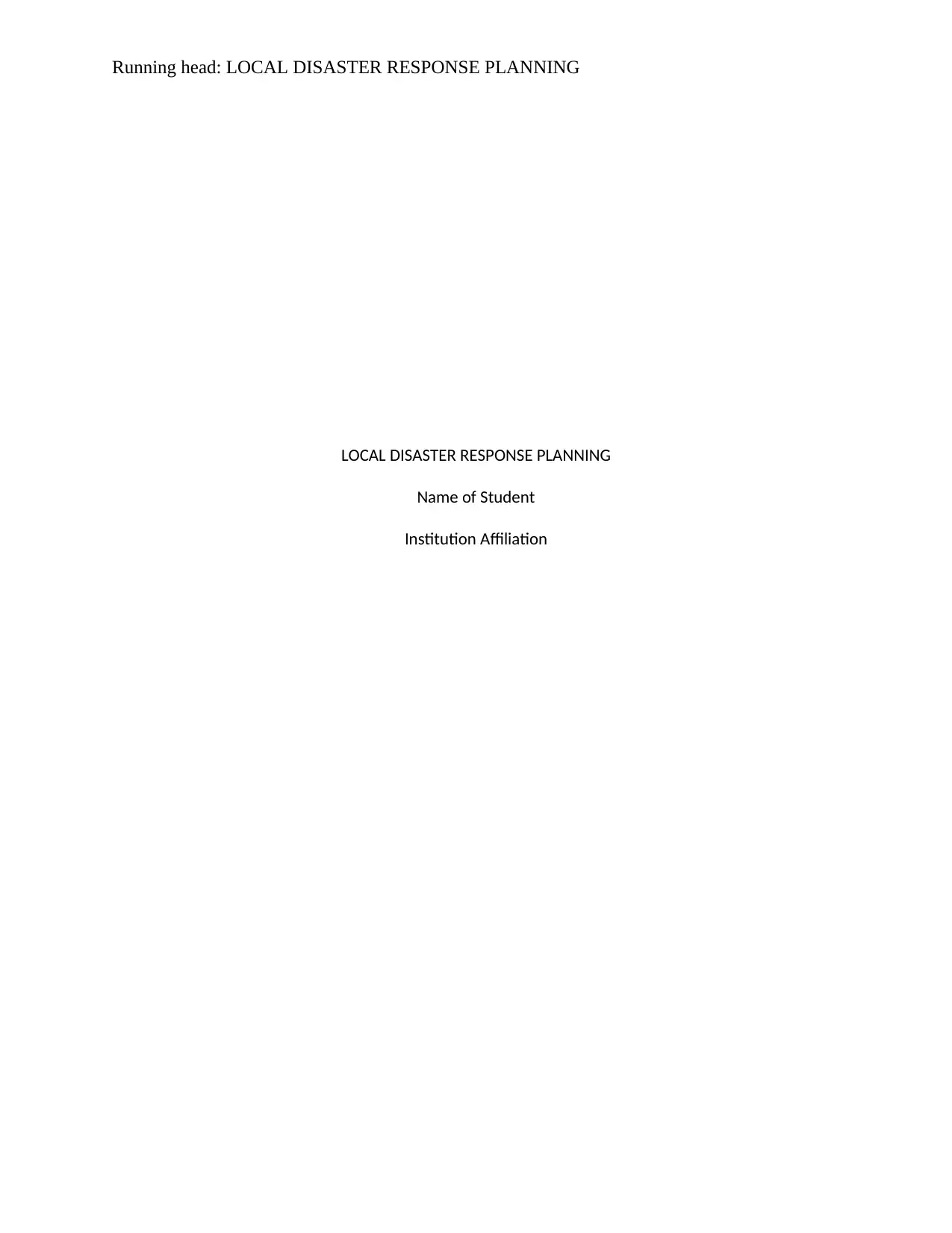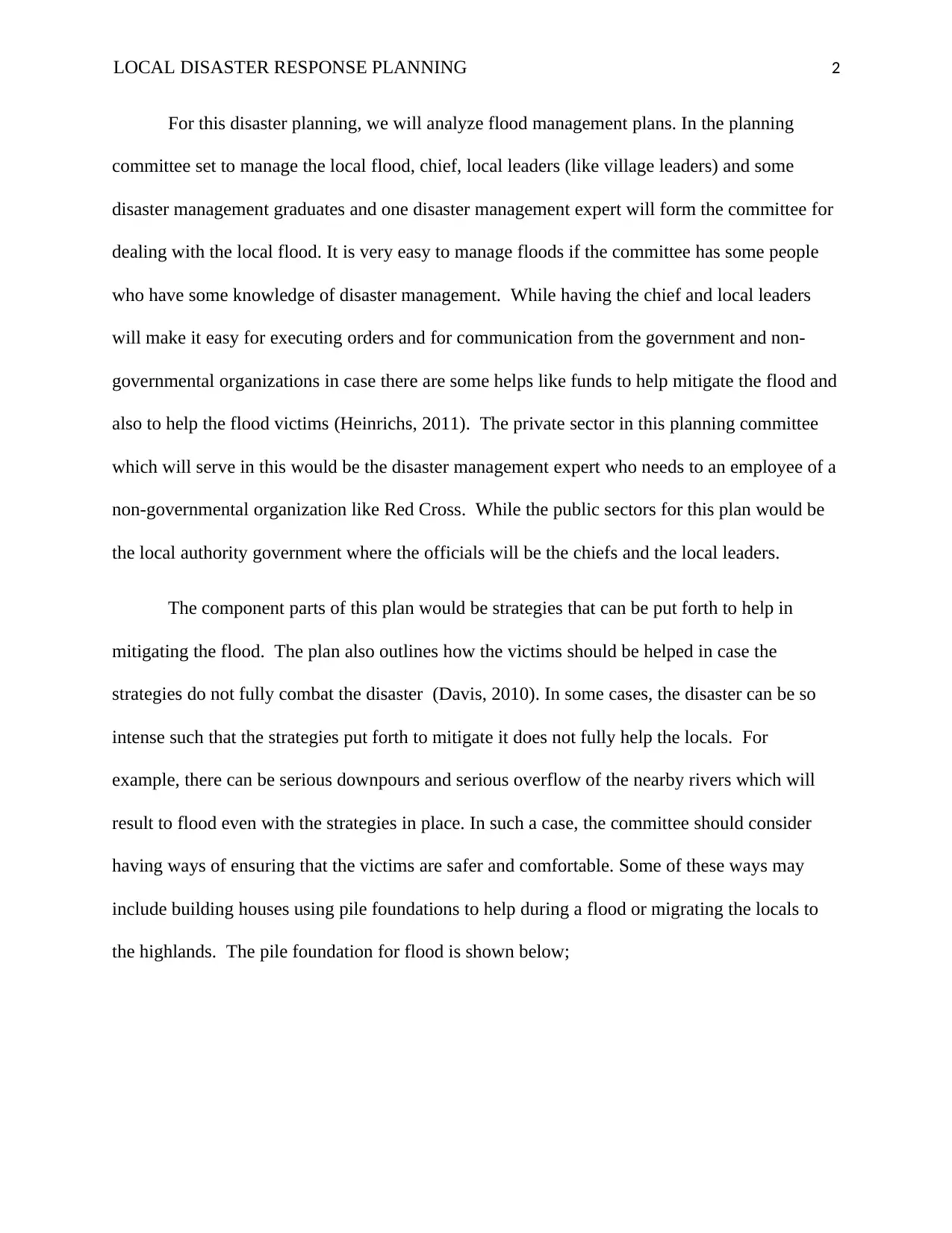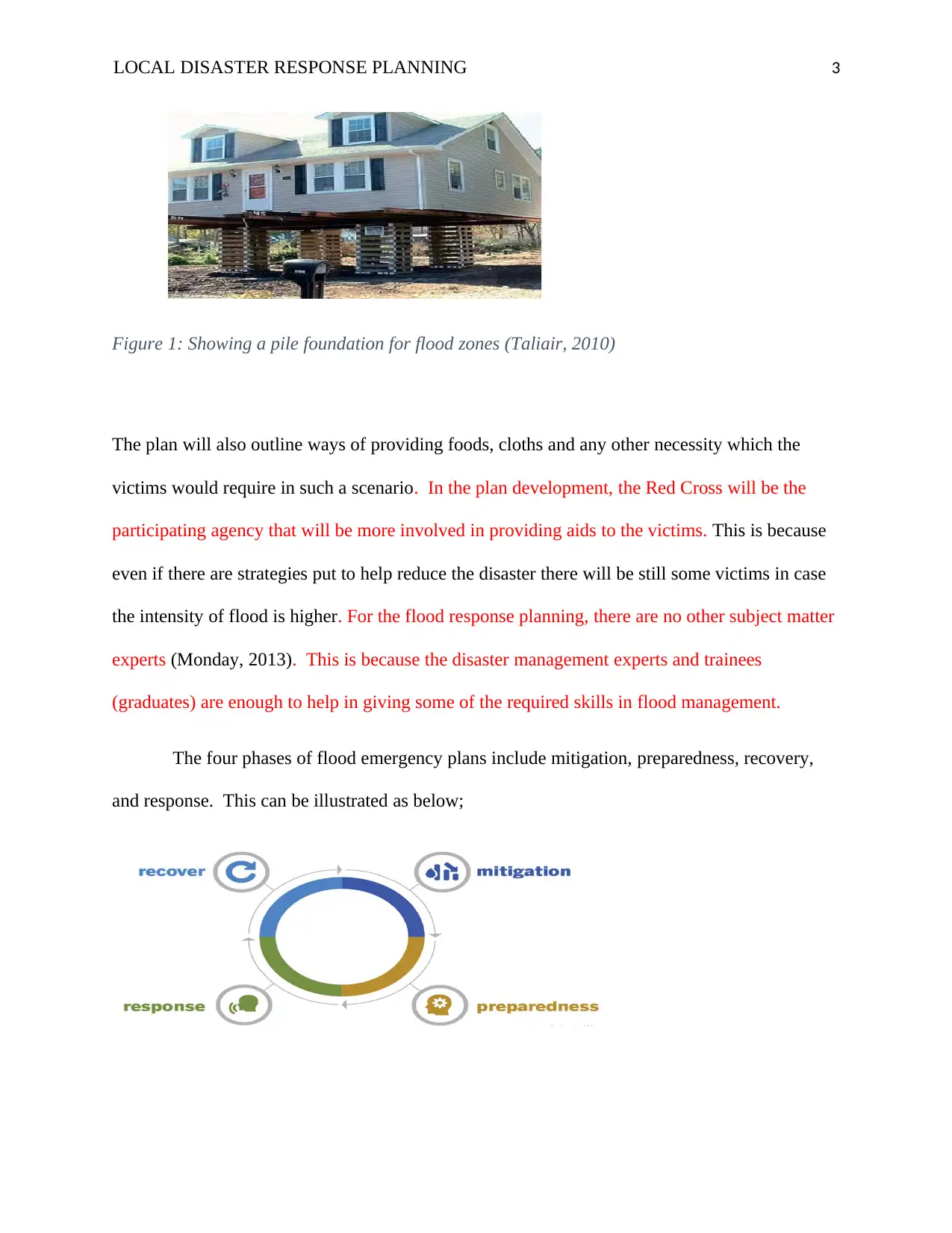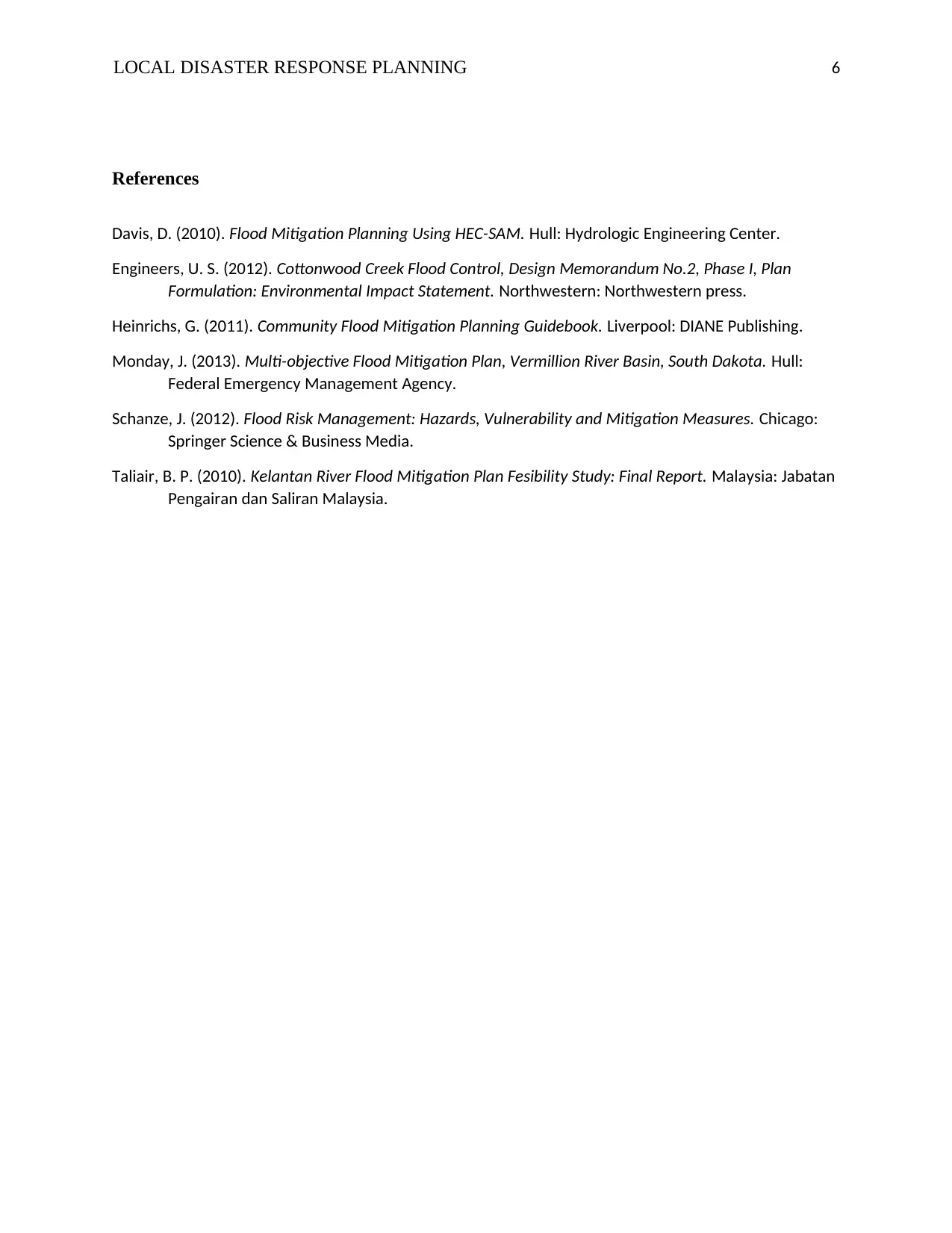Comprehensive Analysis: Local Flood Disaster Response Planning
VerifiedAdded on 2022/08/19
|6
|1043
|16
Report
AI Summary
This report provides a comprehensive analysis of a local flood disaster response plan, focusing on flood management. The plan outlines the formation of a committee comprising local leaders, disaster management experts, and representatives from NGOs to manage floods effectively. It details strategies for mitigation, including building codes and public education, and addresses preparedness through emergency systems and insurance. The report also covers response activities like rescue operations and the recovery phase, involving reconstruction and counseling. Challenges such as lack of information and funding are addressed, with solutions including mutual aid and community involvement. The four phases of flood emergency plans, mitigation, preparedness, response, and recovery, are discussed in detail, providing insights into each stage's activities and importance. The report emphasizes the need for both short-term and long-term recovery strategies, including counseling and infrastructure development, to minimize the impact of floods on the community.

Running head: LOCAL DISASTER RESPONSE PLANNING
LOCAL DISASTER RESPONSE PLANNING
Name of Student
Institution Affiliation
LOCAL DISASTER RESPONSE PLANNING
Name of Student
Institution Affiliation
Paraphrase This Document
Need a fresh take? Get an instant paraphrase of this document with our AI Paraphraser

LOCAL DISASTER RESPONSE PLANNING 2
For this disaster planning, we will analyze flood management plans. In the planning
committee set to manage the local flood, chief, local leaders (like village leaders) and some
disaster management graduates and one disaster management expert will form the committee for
dealing with the local flood. It is very easy to manage floods if the committee has some people
who have some knowledge of disaster management. While having the chief and local leaders
will make it easy for executing orders and for communication from the government and non-
governmental organizations in case there are some helps like funds to help mitigate the flood and
also to help the flood victims (Heinrichs, 2011). The private sector in this planning committee
which will serve in this would be the disaster management expert who needs to an employee of a
non-governmental organization like Red Cross. While the public sectors for this plan would be
the local authority government where the officials will be the chiefs and the local leaders.
The component parts of this plan would be strategies that can be put forth to help in
mitigating the flood. The plan also outlines how the victims should be helped in case the
strategies do not fully combat the disaster (Davis, 2010). In some cases, the disaster can be so
intense such that the strategies put forth to mitigate it does not fully help the locals. For
example, there can be serious downpours and serious overflow of the nearby rivers which will
result to flood even with the strategies in place. In such a case, the committee should consider
having ways of ensuring that the victims are safer and comfortable. Some of these ways may
include building houses using pile foundations to help during a flood or migrating the locals to
the highlands. The pile foundation for flood is shown below;
For this disaster planning, we will analyze flood management plans. In the planning
committee set to manage the local flood, chief, local leaders (like village leaders) and some
disaster management graduates and one disaster management expert will form the committee for
dealing with the local flood. It is very easy to manage floods if the committee has some people
who have some knowledge of disaster management. While having the chief and local leaders
will make it easy for executing orders and for communication from the government and non-
governmental organizations in case there are some helps like funds to help mitigate the flood and
also to help the flood victims (Heinrichs, 2011). The private sector in this planning committee
which will serve in this would be the disaster management expert who needs to an employee of a
non-governmental organization like Red Cross. While the public sectors for this plan would be
the local authority government where the officials will be the chiefs and the local leaders.
The component parts of this plan would be strategies that can be put forth to help in
mitigating the flood. The plan also outlines how the victims should be helped in case the
strategies do not fully combat the disaster (Davis, 2010). In some cases, the disaster can be so
intense such that the strategies put forth to mitigate it does not fully help the locals. For
example, there can be serious downpours and serious overflow of the nearby rivers which will
result to flood even with the strategies in place. In such a case, the committee should consider
having ways of ensuring that the victims are safer and comfortable. Some of these ways may
include building houses using pile foundations to help during a flood or migrating the locals to
the highlands. The pile foundation for flood is shown below;

LOCAL DISASTER RESPONSE PLANNING 3
Figure 1: Showing a pile foundation for flood zones (Taliair, 2010)
The plan will also outline ways of providing foods, cloths and any other necessity which the
victims would require in such a scenario. In the plan development, the Red Cross will be the
participating agency that will be more involved in providing aids to the victims. This is because
even if there are strategies put to help reduce the disaster there will be still some victims in case
the intensity of flood is higher. For the flood response planning, there are no other subject matter
experts (Monday, 2013). This is because the disaster management experts and trainees
(graduates) are enough to help in giving some of the required skills in flood management.
The four phases of flood emergency plans include mitigation, preparedness, recovery,
and response. This can be illustrated as below;
Figure 1: Showing a pile foundation for flood zones (Taliair, 2010)
The plan will also outline ways of providing foods, cloths and any other necessity which the
victims would require in such a scenario. In the plan development, the Red Cross will be the
participating agency that will be more involved in providing aids to the victims. This is because
even if there are strategies put to help reduce the disaster there will be still some victims in case
the intensity of flood is higher. For the flood response planning, there are no other subject matter
experts (Monday, 2013). This is because the disaster management experts and trainees
(graduates) are enough to help in giving some of the required skills in flood management.
The four phases of flood emergency plans include mitigation, preparedness, recovery,
and response. This can be illustrated as below;
⊘ This is a preview!⊘
Do you want full access?
Subscribe today to unlock all pages.

Trusted by 1+ million students worldwide

LOCAL DISASTER RESPONSE PLANNING 4
Figure 2: Showing four phases of flood emergency plan (Engineers, 2012)
MITIGATION
This is the activity that is put forth significantly reduce/ eliminate the flood´s risk before it
occurs. Some of the mitigation activities include the following;
Update and review of building zones and codes Conduct a vulnerability scrutiny Implementing GIS (Geographic Information System) Implement mitigation projects Provide public outreach and education
PREPAREDNESS
This activity is intended to realize a sense of readiness for disaster emergencies. The following
are some of the activities which are undertaken in this phase;
Develop a plan
Doing more practice on flood mitigations.
Use emergency warning systems
Buy flood insurance
Document available infrastructure
Stockpile materials
Figure 2: Showing four phases of flood emergency plan (Engineers, 2012)
MITIGATION
This is the activity that is put forth significantly reduce/ eliminate the flood´s risk before it
occurs. Some of the mitigation activities include the following;
Update and review of building zones and codes Conduct a vulnerability scrutiny Implementing GIS (Geographic Information System) Implement mitigation projects Provide public outreach and education
PREPAREDNESS
This activity is intended to realize a sense of readiness for disaster emergencies. The following
are some of the activities which are undertaken in this phase;
Develop a plan
Doing more practice on flood mitigations.
Use emergency warning systems
Buy flood insurance
Document available infrastructure
Stockpile materials
Paraphrase This Document
Need a fresh take? Get an instant paraphrase of this document with our AI Paraphraser

LOCAL DISASTER RESPONSE PLANNING 5
RESPONSE
This phase of emergency flood management deals with giving immediate assistance like
emergency relief/rescue and search. The activities in this phase will fully rely on the
characteristic of the community.
RECOVERY
This phase bridge the gaps between the normalcy and the emergency, the actions in this phase
may involve reconstruction, temporary housing, education, and counseling. The two activities in
this phase include;
Applying for Grants
Documenting the flood.
Some of the challenges for this plan may include lack of information on how to deal with
the flood, lack of initiative and insufficient funds for conducting the plan (Taliair, 2010). To
solve these challenges there need to be a lot of mutual aid that provides finance and also educates
the general public on how to handle the flood. The general public should also join hands with
the members of the committee during the flood emergency (Schanze, 2012). When the general
public joins hand then it will be easier to find labor when needed for example when constructing
dams and trenches as strategies of reducing the effects of the flood. The short term recovery
from the flood includes counseling, reconstructing shelter and providing food and clothing.
While the long term recovery includes the construction of big dames which can help to collect
water. Construction of dykes will ensure that water is held back to the water body like a river,
RESPONSE
This phase of emergency flood management deals with giving immediate assistance like
emergency relief/rescue and search. The activities in this phase will fully rely on the
characteristic of the community.
RECOVERY
This phase bridge the gaps between the normalcy and the emergency, the actions in this phase
may involve reconstruction, temporary housing, education, and counseling. The two activities in
this phase include;
Applying for Grants
Documenting the flood.
Some of the challenges for this plan may include lack of information on how to deal with
the flood, lack of initiative and insufficient funds for conducting the plan (Taliair, 2010). To
solve these challenges there need to be a lot of mutual aid that provides finance and also educates
the general public on how to handle the flood. The general public should also join hands with
the members of the committee during the flood emergency (Schanze, 2012). When the general
public joins hand then it will be easier to find labor when needed for example when constructing
dams and trenches as strategies of reducing the effects of the flood. The short term recovery
from the flood includes counseling, reconstructing shelter and providing food and clothing.
While the long term recovery includes the construction of big dames which can help to collect
water. Construction of dykes will ensure that water is held back to the water body like a river,

LOCAL DISASTER RESPONSE PLANNING 6
References
Davis, D. (2010). Flood Mitigation Planning Using HEC-SAM. Hull: Hydrologic Engineering Center.
Engineers, U. S. (2012). Cottonwood Creek Flood Control, Design Memorandum No.2, Phase I, Plan
Formulation: Environmental Impact Statement. Northwestern: Northwestern press.
Heinrichs, G. (2011). Community Flood Mitigation Planning Guidebook. Liverpool: DIANE Publishing.
Monday, J. (2013). Multi-objective Flood Mitigation Plan, Vermillion River Basin, South Dakota. Hull:
Federal Emergency Management Agency.
Schanze, J. (2012). Flood Risk Management: Hazards, Vulnerability and Mitigation Measures. Chicago:
Springer Science & Business Media.
Taliair, B. P. (2010). Kelantan River Flood Mitigation Plan Fesibility Study: Final Report. Malaysia: Jabatan
Pengairan dan Saliran Malaysia.
References
Davis, D. (2010). Flood Mitigation Planning Using HEC-SAM. Hull: Hydrologic Engineering Center.
Engineers, U. S. (2012). Cottonwood Creek Flood Control, Design Memorandum No.2, Phase I, Plan
Formulation: Environmental Impact Statement. Northwestern: Northwestern press.
Heinrichs, G. (2011). Community Flood Mitigation Planning Guidebook. Liverpool: DIANE Publishing.
Monday, J. (2013). Multi-objective Flood Mitigation Plan, Vermillion River Basin, South Dakota. Hull:
Federal Emergency Management Agency.
Schanze, J. (2012). Flood Risk Management: Hazards, Vulnerability and Mitigation Measures. Chicago:
Springer Science & Business Media.
Taliair, B. P. (2010). Kelantan River Flood Mitigation Plan Fesibility Study: Final Report. Malaysia: Jabatan
Pengairan dan Saliran Malaysia.
⊘ This is a preview!⊘
Do you want full access?
Subscribe today to unlock all pages.

Trusted by 1+ million students worldwide
1 out of 6
Related Documents
Your All-in-One AI-Powered Toolkit for Academic Success.
+13062052269
info@desklib.com
Available 24*7 on WhatsApp / Email
![[object Object]](/_next/static/media/star-bottom.7253800d.svg)
Unlock your academic potential
Copyright © 2020–2025 A2Z Services. All Rights Reserved. Developed and managed by ZUCOL.


